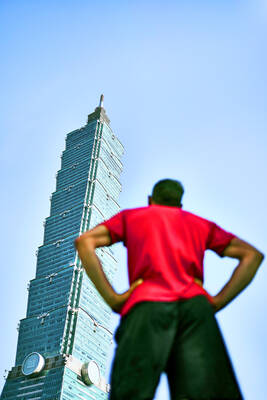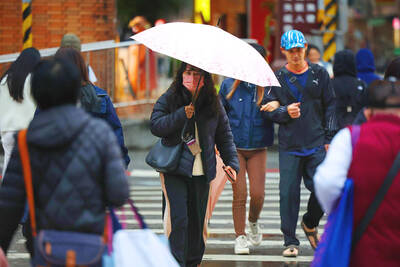Factories emitting fine particulate pollutants such as PM2.5 will have to pay an air pollution tax from next year, Environmental Protection Administration (EPA) officials said yesterday, adding that new standards for the tax are to be launched by the end of this year.
Drafting the rules is expected to be finalized by the end of this year and they are scheduled to be put in place in April at the earliest, the EPA said.
According to the Standards of Air Quality (空氣品質標準), the nation’s annual average PM2.5 concentration should be kept below 15 micrograms per cubic meter (mcg/m3).
However, the average level of PM2.5 last year was 20mcg/m3, EPA data showed.
At an impromptu news conference yesterday, EPA Deputy Minister Chan Shun-kuei (詹順貴) said that the concentrations of sulfur dioxide and nitrogen oxides in air have been falling, but the improvement in overall air quality might not be that obvious.
The news conference was held in response to specific media reports yesterday that the EPA had done little to improve air quality, even though it has collected an air pollution tax since 1995.
A report by the Chinese-language United Daily News blamed the EPA for targeting only mobile pollution sources rather than large-scale and fixed polluting facilities.
The average level of sulfur dioxide has been reduced by 43 percent over the past 11 years, while that of PM2.5 has fallen by 17 percent since 2013, EPA Department of Air Quality Protection and Noise Control Director-General Tsai Hung-teh (蔡鴻德) said.
About 8,000 factories that emit PM2.5 particles will be required to pay air pollution fees, which the EPA estimated would generate NT$1.2 billion (US$39.8 million) to be used toward controlling air pollution, Tsai said.
In the initial stage, air pollution fees are to be categorized into “spring-summer” and “autumn-winter” schedules, all of which are to be classified into three grades according to the volume of emissions, he added.
State-run power plants are required to adopt more efficient power generators and the best available pollution control technology to reduce emissions, Tsai said, adding that the nation’s power plants are expected to cut polluting emissions by about 33 percent, from 99,000 tonnes of air pollutants last year to 66,000 tonnes in 2026.
New standards for the air pollution tax on stationary sources are to be launched by the end of this year and factories emitting air pollutants, such as fine particles and heavy metals, would be taxed, he said.
The EPA would also collect tax from gas-fired plants that emit nitrogen oxides, Tsai added.
“By the end of 2019, we hope to push the annual average PM2.5 level down to 18mcg/m3,” Chan said.
If China continues to curb air pollution by prohibiting coal burning, Taiwan’s air quality could benefit as well and the nation is likely to achieve the legal annual maximum concentration of 15mcg/m3 by 2019, he said.
Chan added that the EPA would propose more measures to improve air quality if it failed to achieve the goal by then.
Additional reporting by CNA

US climber Alex Honnold is to attempt to scale Taipei 101 without a rope and harness in a live Netflix special on Jan. 24, the streaming platform announced on Wednesday. Accounting for the time difference, the two-hour broadcast of Honnold’s climb, called Skyscraper Live, is to air on Jan. 23 in the US, Netflix said in a statement. Honnold, 40, was the first person ever to free solo climb the 900m El Capitan rock formation in Yosemite National Park — a feat that was recorded and later made into the 2018 documentary film Free Solo. Netflix previewed Skyscraper Live in October, after videos

Starting on Jan. 1, YouBike riders must have insurance to use the service, and a six-month trial of NT$5 coupons under certain conditions would be implemented to balance bike shortages, a joint statement from transportation departments across Taipei, New Taipei City and Taoyuan announced yesterday. The rental bike system operator said that coupons would be offered to riders to rent bikes from full stations, for riders who take out an electric-assisted bike from a full station, and for riders who return a bike to an empty station. All riders with YouBike accounts are automatically eligible for the program, and each membership account

NUMBERS IMBALANCE: More than 4 million Taiwanese have visited China this year, while only about half a million Chinese have visited here Beijing has yet to respond to Taiwan’s requests for negotiation over matters related to the recovery of cross-strait tourism, the Tourism Administration said yesterday. Taiwan’s tourism authority issued the statement after Chinese-language daily the China Times reported yesterday that the government’s policy of banning group tours to China does not stop Taiwanese from visiting the country. As of October, more than 4.2 million had traveled to China this year, exceeding last year. Beijing estimated the number of Taiwanese tourists in China could reach 4.5 million this year. By contrast, only 500,000 Chinese tourists are expected in Taiwan, the report said. The report

Temperatures are forecast to drop steadily as a continental cold air mass moves across Taiwan, with some areas also likely to see heavy rainfall, the Central Weather Administration (CWA) said. From today through early tomorrow, a cold air mass would keep temperatures low across central and northern Taiwan, and the eastern half of Taiwan proper, with isolated brief showers forecast along Keelung’s north coast, Taipei and New Taipei City’s mountainous areas and eastern Taiwan, it said. Lows of 11°C to 15°C are forecast in central and northern Taiwan, Yilan County, and the outlying Kinmen and Lienchiang (Matsu) counties, and 14°C to 17°C